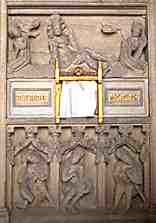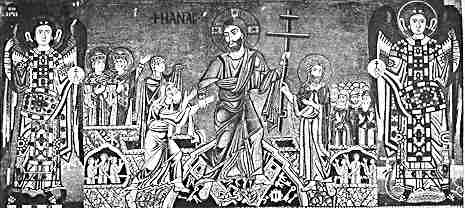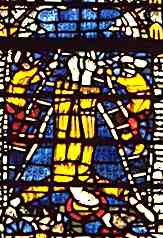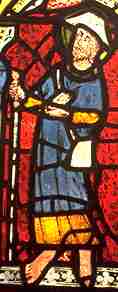




If you are looking at this page without frames, there is more information about medieval writing to be found by going to the home page (framed) or the site map (no frames).
| New Testament Apocrypha (2) | ||||
| The discovery of the Gnostic library at Nag Hammadi, packed into a clay pot, revealed the full text, in Coptic, of a gospel known as the Gospel of Thomas, previously known only from fragments, which contained sayings of Jesus. Such isolated discoveries emphasise the fragility of the written word. More prolific were apocryphal works which filled out the details of the end of Christ's life: the Passion, the Crucifixion and the Resurrection. Strange to tell, even this well known part of the story has its gaps and inconsistencies. | ||||
 |
The process of Christ's arising from the tomb does not occur in any gospel account. The empty sepulchre is simply discovered by the women visiting the tomb. Divergent accounts are then given of Christ's appearance to various people. This deficiency in the official text was made up in church art, where the image of Christ rising from the tomb with the sleeping soldiers beneath became an iconographic standard, particularly favoured as carving on Easter sepulchres, those repositories for the host for the Easter mass. | |||
| Late medieval Easter Sepulchre in Patrington church, Yorkshire. | ||||
| A problem for Christians, still being explored in the 14th century by Dante, was that of the virtuous pagans and Jewish fathers of the Christian religion who had the misfortune to be born before the time of Christ, and were therefore unable to have been baptised into the Christian faith. An episode of the Resurrection, referred to as the harrowing of Hell, in which Christ storms the gates of Hades to rescue Adam and the other Jewish fathers, comes not from the canonical gospels, but is found in an apocryphal text called the Gospel of Nicodemus, a fifth or sixth century compilation probably based on two earlier texts. This dramatic image appears in church art, and the episode was played out in church theatrical. | ||||
 |
||||
| The harrowing of Hell, as depicted in Byzantine style in a nave mosaic in Torcello Cathedral, Sicily. | ||||
 |
The mouth of hell, as depicted very high up in a stained glass window in the nave clerestory of York Minster, in the manner that it was depicted in the Mystery Plays. I could have got a better picture if I had had a personal hovercraft, but you can make out the monstrous face with a row of big white teeth on the right, with the figures emerging from it. | |||
| The same apocryphal text added much detail about that most enigmatic character, both morally and theologically, Pontius Pilate. It also introduced briefly a character called Berenice, or Veronica, who was to feature in a much later medieval legend as the woman who wiped Christ's face with her handkerchief, leaving the impression of his face on the sacred relic. | ||||
| The New Testament Acts of the Apostles is also curiously inadequate in providing the necessary mythology of the early founders of the church. It is from apocryphal texts, some dating from as early as the second century, but many adapted much later, that the stories of the lives and martyrdoms of the apostles were created. Evidently the church expurgated and edited some of the narratives over the centuries, but the stories of the martyrdoms remained for the inspiration of the faithful, and were much reproduced in art. |  |
|||
| The martyrdom of St Peter, by being crucified upside down, as depicted in a 14th century stained glass window in York Minster. | ||||
 |
Many of these tales are reproduced in The Golden Legend, assembled from a variety of sources. You can find out on what grounds the mighty church of Santiago de Compostella became the greatest pilgrimage place in medieval Europe, based on some apocryphal legends about St James the Great. | |||
| A complete modern English translation is that of W.G. Ryan 1993. | ||||
| St James the great depicted as a pilgrim in a 14th century stained glass window in the church of St Mary Castlegate, York. | ||||
If you are looking at this page without frames, there is more information about medieval writing to be found by going to the home page (framed) or the site map (no frames). |
||||